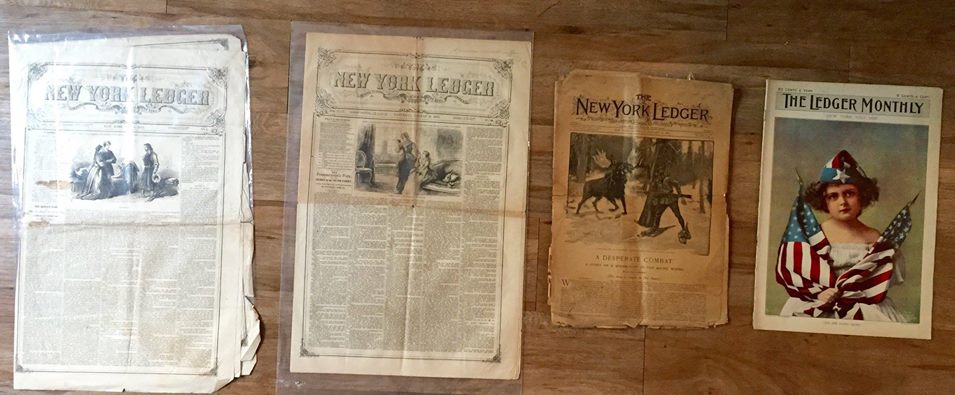|
Robert E. Bonner’s story paper The New York Ledger went through a number of aesthetic and textual changes during its run, from 1855 until 1898. In 1887, Bonner’s three sons inherited the paper and soon after made changes to it which Bonner Sr. would’ve abhorred. For instance, Bonner’s sons included advertisements for furniture, medicine, and ivory soap in the Ledger. When Bonner Sr. was editor, he did not publish advertisements in the Ledger unless they were self-promotional,promoting his paper and/or contributors. The paper also changed in size. The two Ledger copies on the left are earlier prints (1859 and 1883), similar in size and printed during Bonner Sr.’s years as editor and proprietor. The smaller copy next to the larger ones is an example of the paper’s transition from a monthly to a weekly, i.e., from The New York Ledger (weekly) to the Ledger Monthly. Many other modifications came along with the changes made to the paper’s size and installment sequence. I’ve noticed that the later Ledgers, both as monthly and weekly, place a lot of emphasis on illustrations, including wood engravings in the early copies and photography in the later ones. Poetry also became scarce in these later copies. Lesser-known contributors and more obscure stories and poems replaced some of the big names in poetry and prose, many of which, including William Cullen Bryant and Charles Dickens , Bonner heavily promoted during his tenure as editor. The Ledger Monthly featured attractive cover art and its content became much more commercial and advertisement-driven, which makes it sometimes difficult to clearly identify the Monthly’s targeted audience and subscribers. While I find it clear that Bonner's Ledger was a literary paper, appealing to an audience interested in popular poetry and prose, I cannot say the same for The Ledger Monthly. The Monthly's content casts a wide net on its would-be audience, which begs the question, who was reading this magazine and why?
27 Comments
9/8/2020 09:59:51 pm
I am really happy to find this blog. The information shared is really unique and interesting.
Reply
9/11/2022 01:18:02 pm
Really informative article, I had the opportunity to learn a lot, thank you. https://kurma.website/
Reply
9/30/2022 07:48:49 am
It's great to have this type of content. Good luck with your spirit. Thank you. https://bit.ly/site-kurma
Reply
10/4/2022 10:32:58 pm
I think this post is useful for people. It has been very useful for me. Looking forward to the next one, thank you. https://escortnova.com/escort-ilanlari/samsun-escort/ilkadim-escort/
Reply
10/5/2022 03:33:10 pm
I follow your posts closely. I can find it thanks to your reliable share. Thank you. https://escortnova.com/escort-ilanlari/giresun-escort/bulancak-escort/
Reply
10/6/2022 09:21:18 am
I support your continuation of your posts. I will be happy as new posts come. Thank you. https://escortnova.com/escort-ilanlari/kayseri-escort/develi-escort/
Reply
10/7/2022 02:49:03 am
I think the content is at a successful level. It adds enough information. Thank you. https://escortnova.com/escort-ilanlari/kastamonu-escort/inebolu-escort/
Reply
10/7/2022 04:47:31 pm
Thank you for your sharing. I must say that I am successful in your content. https://escortnova.com/escort-ilanlari/gaziantep-escort/sehitkamil-escort/
Reply
10/8/2022 11:48:18 am
Thoughtful and real content is shared. Thank you for these shares. https://escortnova.com/escort-ilanlari/sinop-escort/gerze-escort/
Reply
11/21/2022 11:15:39 pm
Sitemizi ziyaret et ve evden is imkanina bak: https://sites.google.com/view/evden-ek-is/
Reply
12/9/2022 10:29:23 pm
Uygun fiyatlardan takipçi satın al: https://takipcialdim.com/
Reply
12/10/2022 01:09:34 am
İnstagram beğeni takipçi satın al: https://takipcialdim.com/instagram-begeni-satin-al/
Reply
12/10/2022 01:11:12 am
Tiktok takipçi satın almak için tıkla: https://takipcialdim.com/tiktok-takipci-satin-al/
Reply
12/15/2022 08:00:57 pm
takipci satın almak için tıkla: https://takipcim.com.tr/
Reply
1/8/2023 10:20:58 pm
100 tl deneme bonusu veren siteleri öğrenmek istiyorsan tıkla.
Reply
8/15/2023 01:50:49 pm
https://nobetci-eczane.org/tokat-yesilyurt-nobetci-eczane/ teşekkürler
Reply
Leave a Reply. |
AuthorAyendy Bonifacio Archives
March 2018
Categories |

 RSS Feed
RSS Feed
